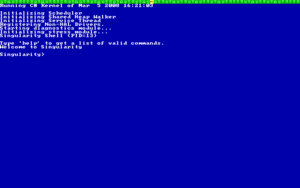Singularity (operating system)

Singularity after boot-up.
|
|
| Developer | Microsoft Corporation |
|---|---|
| Written in | Assembly language, C, C++, C#, Sing# |
| OS family | Language-based operating systems |
| Working state | Abandoned |
| Source model | Shared source |
| Latest release | 2.0 / November 14, 2008 |
| Platforms | x86 |
| Kernel type | Microkernel Language based |
| Default user interface | Command line interface |
| License | Microsoft Research License |
| Official website | research |
Singularity was an experimental operating system built by Microsoft Research between 2003 and 2010. It was designed as a highly-dependable OS in which the kernel, device drivers, and applications were all written in managed code.
The lowest-level x86 interrupt dispatch code is written in assembly language and C. Once this code has done its job, it invokes the kernel, whose runtime and garbage collector are written in Sing# (an extended version of Spec#, itself an extension of C#) and runs in unprotected mode. The hardware abstraction layer is written in C++ and runs in protected mode. There is also some C code to handle debugging. The computer's BIOS is invoked during the 16-bit real mode bootstrap stage; once in 32-bit mode, Singularity never invokes the BIOS again, but invokes device drivers written in Sing#. During installation, Common Intermediate Language (CIL) opcodes are compiled into x86 opcodes using the Bartok compiler.
Singularity is a microkernel operating system. Unlike most historical microkernels, its components execute in the same address space (process), which contains "software-isolated processes" (SIPs). Each SIP has its own data and code layout, and is independent from other SIPs. These SIPs behave like normal processes, but avoid the cost of task-switches.
...
Wikipedia
